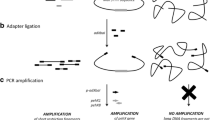Abstract
Nosocomial infections due toAcinetobacter baumannii dramatically increased in a Lebanese medical center following an outbreak of hostilities in Lebanon in 1984. The incidence of infection caused by this organism has remained high in this institution, thus requiring the implementation of a strain typing system to aid in infection control. Three methods were investigated for their utility in differentiating among a representative group of 36 nosocomialAcinetobacter baumannii isolates obtained over a 10 month period from specimens of hospitalized patients. Isolates were typed by antibiogram analyses, plasmid fingerprinting, and total cell protein profiles. Only three distinct total cell protein profiles were detected, with one pattern accounting for 26 (72.2%) of the isolates. However, eight different plasmid profiles were observed, with 20 (55.5%) isolates having the same profile. Eleven distinct antibiograms were seen with the most prevalent pattern occuring in 21 isolates. Twenty of the 21 (95%) isolates with the common antibiogram also had the same plasmid profile and total protein profile (44.4% of total isolates). The combination of these three typing methods was useful in tracing the spread of these organisms in the medical center. The data obtained suggest the distribution of a common strain among at least six wards of this hospital.
Similar content being viewed by others
References
Alexander M., Rahman M. andNoble W.C. (1988): A study of the value of electrophoretic and other techniques for typingAcinetobacter calcoaceticus. — J. Hosp. Inf.,12: 273–287.
Andrews H.J. (1986):Acinetobacter bacteriocin typing. — J. Hosp. Inf.,7: 169–175.
Bauman P. (1968): Isolation ofAcinetobacter from soil and water. — J. Bacteriol.96: 39–42.
Beck-Saque C.M., Jarvis W.R., Brook J.H., Culver D.H., Potts A., Gay E., Shotts B.W., Hill B., Anderson R.L. andWeinstein M.P. (1990): Epidemic bacteremia due toAcinetobacter baumanni in five intensive care units — Am. J. Epidemiol.132: 723–733.
Bergogne-Berezin E., Joly-Guillou M.L. andVieu J.F. (1987): Epidemiology nosocomial infections due toAcinetobacter calcoaceticus. — J. Hosp. Inf.10: 105–113.
Bergogne-Berezin E. andJoly-Guillou M.L. (1985): An underestimated nosocomial pathogen,Acinetobacter calcoaceticus. — J. Antimicrob. Chemo.16: 535–538.
Birnboin H.C. andDoly J. (1979): A rapid alkaline extraction procedure for screening recombinant plasmid DNA. — Nucl. Ac. Res.7: 1513–1523.
Bouvet P.J.M. andGrimont P.A.D. (1986): Taxonomy of the genusAcinetobacter with the recognition ofAcinetobacter baumanni sp. nov.,Acinetobacter haemolyticus sp. nov.,Acinetobacter Johnsonii sp. nov., andAcinetobacter calcoaceticus andAcinetobacter lwoffii. — Int. J. Syst. Bacteriol.36: 228–240.
Bouvet P.J.M., Jeanjean S., Vieu J-F. andDijkshoorn L. (1990): Species biotype and bacteriophage type determination compared with cell envelope protein profiles for typingAcinetobacter strains. — J. Clin. Microbiol.28: 170–172.
Bouvet P.J.M. andGrimont P.A.D. (1987): Identification and biotyping of clinical isolates ofAcinetobacter. — Ann. Microbiol. (Institut Pasteur).138: 569–578.
Das B.C. andAyliffe G.A.F. (1984): Serotyping ofAcinetobacter calcoaceticus. — J. Clin. Pathol.37: 1388–1391.
Dijkshoorn L., Wubbels J.L., Beunders A.J., Degener J.E., Boks A.L. andMichel M.F. (1989): Use of protein profiles to identifyAcinetobacter calcoaceticus in a respiratory care unit. — J. Clin. Pathol.42: 853–857.
Elliott J.A., Bosley G.S., Carlone G.M., Plitaykis B.D. andFacklam (1987): Separation ofHaemophilus influenzae type b subtypes by numerical analysis. — J. Clin. Microbiol.25: 1476–1480.
Farrar W.E. (1983): Molecular analysis of plasmids in epidemiologic investigation. — J. Inf. Dis.148: 1–6.
French G.L., Casewell M.W., Roncoreoni A.J., Knight S. andPhilips I. (1980): A hospital outbreak of antibiotic-resistantAcinetobacter anitratus: epidemiology control. — J. Hosp. Inf.1: 125–131.
Gerner-Smidt P. (1989): Frequency of plasmids in strains ofAcinetobacter calcoaceticus. — J. Hosp. Inf.14: 23–28.
Getchell-White S.I., Donowitz L.G. andGroschel D.H.M. (1989): The inanimate environment of nosocomial bacteria: evidence for long survival ofAcinetobacter calcoaceticus. — Inf. Cont. and Hosp. Epidemiol.10: 402–407.
Glew R.H., Moellering R.C. andKunz L.J. (1977): Infections withAcinetobacter calcoaceticus (Herella vaginicola): Clinical and laboratories studies. — Med.56: 79–97.
Goodhart G.L., Abrutyn E., Watson R., Root R.K. andEgert J. (1977): Community-acquiredAcinetobacter calcoaceticus varanitratus pneumonia. — J. Am. Med. Assoc.238: 1516–1518.
Laemelli U.K. (1970): Cleavage of structural proteins during the assembly of the head of bacteriophage T4. — Nature (London).227: 680–685.
LeMaistre A., Mortensen J., La Rocco M. andRobinson A. (1985): An outbreak of multiply resistantAcinetobacter anitratus in an intensive care unit. —Clin. Microbiol. Newslett.7: 102–103.
Mayer L.W. (1988): Use of plasmid profiles in epidemiologic surveillance of disease outbreaks and in tracing the transmission of antibiotic resistance. —Clin. Microbiol. Rev.1: 228–243.
Murray R.E. andMoellering R.C. (1979): Aminoglycoside-modifying enzymes among clinical isolates ofAcinetobacter calcoaceticus subsp.anitratus (Herella vaginicola): explanation for high-level aminoglycoside resistance. — Antimicrob. Ag. Chemo.1: 190–199.
Ritucia P.A. andCunha B.A. (1983): Topics in clinical microbiology. — Inf. Cont.4: 226–229.
Rudin M.L., Michael J.R. andHuxley E.J. (1979): Community-acquiredAcinetobacter pneumonia. —Am. J. Med.7: 39–43.
Sambrock J., Fritsch E.F. andManiatis T. (1989): Molecular cloning. A laboratory manual. — Cold Spring Harbor Laboratory Press. Cold Spring Harbor.
Shaberg D.R., Tompkins L.S. andFalkow S. (1981): Use of agarose gel electrophoresis of plasmid deoxyribonucleic acid to fingerprint gram-negative bacilli. J. Clin. Microbiol.13: 1105–1108.
Taplin D., Rebel G. andZaias N. (1963): The human skin as a source ofMima-Herella infections. — J. Am. Med. Ass.186: 952–955.
Towner K.J. andChopade B.A. (1987): Biotyping ofAcinetobacter calcoaceticus using the API 20 NE system. — J. Hosp. Inf. 10: 145–151.
Author information
Authors and Affiliations
Rights and permissions
About this article
Cite this article
Matar, G.M., Gay, E., Cooksey, R.C. et al. Identification of an epidemic strain ofAcinetobacter baumanii using electrophoretic typing methods. Eur J Epidemiol 8, 9–14 (1992). https://doi.org/10.1007/BF02427385
Published:
Issue Date:
DOI: https://doi.org/10.1007/BF02427385




